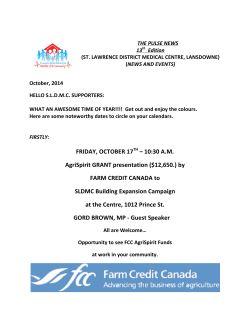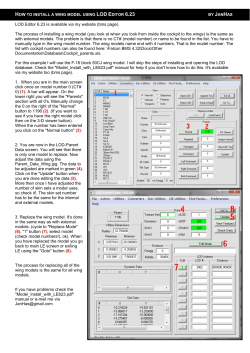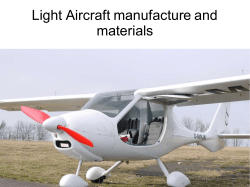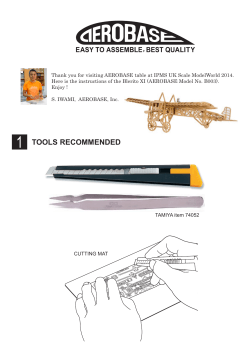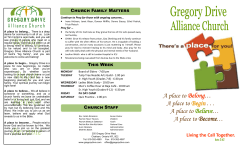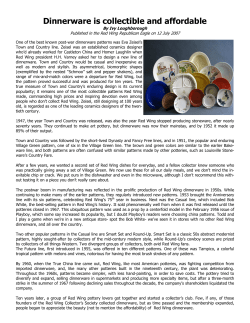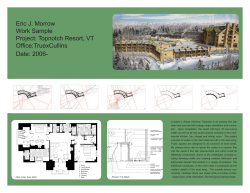
Document 403058
Sport-scale 2-place aerobatic trainer HAD designed a 1/4-scale model of the Su-26, so the decision to build the new Su-29 was not difficult to make. After receiving 3-view drawings and technical information from Bob Banka at Scale Model Research*, I started my new project. I decided on an 80-inch-span model that would be IMAA-legal and light enough to fly with my trusty SuperTigre* .90. I knew my .90 would easily pull a 10-pound model, so that was my target weight (minus fuel, the finished weight was 10 pounds, 4 ounces). When I had finished all of the designing, I started the construction process with the wing. by MARK SIRIANNI CONSTRUCTION • Wing. Pick a piece of hard, 1/8-inch balsa and make the leading-edge (LE) jig. The jig tapers from l3/4 inches to 3/4 inch, with the thicker end under the wing center and the thinner end under rib 12. Pin the 3/32x4-inch trailing-edge (TE) sheeting over the plans. Glue the bottom 1/8x1/4-inch spar into place on top of the TE sheeting. Pin all the ribs to the jig and to the bottom spar. Make sure the ribs are flat on the T E sheet ing. When y o u ' r e satisfied with the fit, CA the ribs to the bottom spar and the TE sheeting. Three generations help to make this flight a success. I check the engine while my Dad and son, Tom, hold the plane. Add the top 3/8-inch-square spruce spar. Add the top 1/8x1/4- inch TE spar. Glue the 1/4-inch thick plywood aileron-control-horn plate between ribs 5 and 6. Sand the tops of the ribs flush with the top spar, and add the balsa filler block at rib 1. Glue on the top LE sheeting. Add the 1/2-inch leading edge. Add the 3/32x4-inch-wide LE sheeting. Do not sheet the landing-gear area at this time; this will be done after the gear has been installed. Keep the wing pinned to the jig until the glue has dried completely; then turn it over and glue the bottom 3/8-inchsquare spruce spar into place. Do not add the bottom TE sheeting yet. Build the left wing panel up to this point. The wing panels are joined upside-down on a flat work surface. Cut an 1/8-inch slot at the rear edge of the spar and rib 1. This will allow the dihedral brace to slide through. Lay some wax paper over the center of your plans, and pin the panels over the wing top view. Keep the top spar flat on the work surface. Epoxy the dihedral brace securely to the backs of the main spars, and let the epoxy cure completely. Epoxy the 1/8-inch-plywood ribs (1A) into place. They should be flush with the top of wing rib 1. This rib sets the proper angle for the landing-gear plate. Here's the Su-29 (right) with its counterpart, the Su-26. Both great flying models and will provide hours of aerobatic fun. are Epoxy the l a n d i n g - g e a r plate into position. This is a very important part of the wing because all the stress of the landing gear will be on this plate. Drill two 3/8-inch-diameter holes in the front dowel plate, and then epoxy the plate into place. Do not install dowels yet. Add the bottom 3/32-inch-thick LE sheeting. Install the landing gear with 6/32-inch screws and blind nuts. Use epoxy around the blind nuts to make sure they do not come loose. Sheet the top center section of the wing, but don't sheet the bottom until later. Install the 3/32-inch-thick ver tical-grain shear webs and the tubes for the aileron wires. The ailerons were cut out of the completed wing, finished with a leading edge, then hinged into place. Install the aileron servo rails and the servos. Sand the wing and then set it aside until later. • Tail surfaces. These are con structed over the plans. Each is a 1/4-inch-square balsa framew o r k s h e e t e d on both sides with 1/16-inch-thick balsa (I used 6-inch-wide Sig* balsa sheet). Make sure you have the lite-ply control-horn bases on both elevator halves. Let the glue dry; then sand the tail sur faces to shape and set aside. Use your engine as a guide to deter mine how far back to position F3. The plans show the approximate position for a 1.20 4-stroke. Mount the aluminum engine mount on F3 and F3B. Carefully draw a centerline on each of these, and attach the mount using 8-32 screws and blind nuts. Glue F3 into place; then add F4, F5 and F6. Build your tank compart ment to suit your tank. Glue the remain ing top formers into place. Carefully check the rearward slant of F9. Add the 1/8-inch balsa cockpit floor and instru ment panels 1 and 2. Glue in the top tur tle deck 1/4-inch-square balsa and 1/4inch-square spruce stringers. The middle 1/4-inch-squarespruce stringer should be parallel to your work surface. This is the The completed tail framework. This type of construction the model from being tail-heavy. • Fuselage. This is built in top and bot tom halves over the 1/4-inch-square balsa crutch. T h e 1/4-inch-square crutch is pinned over the top view of the plans; the top-half formers are then glued to it. Add the 1/4-inch-square spruce crutch doubler. Glue two Fl formers together; glue F2 to the back of Fl. base on which the stab sits, so it must be level. Add the 1/4-inch balsa filler under the stab and let the top half of the fuse lage dry. When it's dry, sheet the entire top with soft 3/32-inch balsa. Keep the framework securely pinned to the work surface, and use aliphatic resin glue so SPECIFICATIONS Scale: 1/4-scale aerobatic monoplane Wingspan: 80 in. Length: 543/4 in. (including spinner) Wing area: 1,036 sq. in. Weight: 10 lb., 4 oz. Wing loading: 22.80 oz./sq. ft. No. of channels req'd: 4 (elevator, rudder, aileron, throttle) and 5 servos Engine req'd: .90 2-stroke or 1.20 4-stroke Comments: this IMAA-legal, sportaerobatic model is easy to fly. of F9, F10 and F11 after the glue has dried. Add the 1/2-inch-thick-balsa top. Cut it a little oversize to allow for shaping. When the top is dry, unpin the top portion of the fuse and turn it over in prepa ration for building the bottom. Glue two F I B formers together, and glue F2B to the b a c k of t h e m . Glue F3B into place. Check its fit by attach helps to prevent ing your engine mount to F3 and F 3 B . Epoxy F3B, F4B and F5B into place, making sure they are straight. Add the bottom 1/4-inch-square balsa stringer. Epoxy the 1/8-inch aircraft-grade ply wood dowel doubler to the back of F5B. Place the fuselage upside-down in a Robart* stand, and level the fuse with the work surface. If you have an inci dence meter, the next steps will be much easier. Put the wing into place on the fuselage. To mark the dowel locations on F5B, I used a 1/4-inch doweling center—a metal plug that has a sharp point on one end. The plug fits into the holes in the front dowel plate. Simply set the wing in the wing saddle area at zero incidence and press it forward. The doweling centers will put small marks on F5B at the exact places where the holes The wing ribs on the leading-edge jig have been should be drilled. A l s o , carefully pinned into place. The m e a s u r e the d i s t a n c e from e a c h trailing-edge spars, bottom wingtip to the tail post; make sure trailing-edge sheeting and the top main spar are In both distances are equal. place. In this fuselage, setup. there's plenty of room for any radio. Here's my that y o u ' l l have plenty of time to get things pinned into place. Sand the tops When you are satisfied that every thing is aligned, drill the holes in F5B. Remove the wing from the fuselage and, using a long drill bit, drill two holes for the rear dowels in the 1/8-inch plywood When a wing panel Is complete, the ailerons are cut free; the trailingedge cap and the aileron cap are In place. dihedral brace. Epoxy the dowels into place, and finish sheeting both sides of the wing. Epoxy the lx6-inch hardwood wing holddown block into place. Try the wing on the fuselage and check its fit. Measure wingtip to wingtip, and when you're satisfied with the measurement, drill holes through the wing and into the hardwood block. Drill and tap for a 1/4-inch nylon bolt. Sheet the front bottom of the fuselage. Add the rear bottom for m e r s and the 1 / 4 - i n c h square balsa stringers. Plan your pushrod instal lation and then sheet the fuselage bottom with soft balsa. Test fit and level t h e s t a b on t o p of the 1/4-inch-square spruce stringers. Add the ply wood stab base between the s t r i n g e r s . I usually use a screw to attach the The forward top section of the fuselage showing the framework and the tank compartment. stab to its base. Drill 1/4-inch holes through the plywood base and the stab for the fin dowels. Add soft balsa blocks to the side of the fin and sand it to shape. With the wing firmly attached to the fuselage, it's time to build the belly pan and the removable hatch. Set formers H8 and H5 into place. Glue rear H6 and H8 to the wing. Add the 1/4-inch-square stringers b e t w e e n H5 and H 8 . Cut the stringers between the two H6 formers and remove the forward por tion of the fuse. This is the removable section that will cover the landing gear. Sheet the belly pan and removable hatch with 3/32-inch-thick balsa. The hatch is attached The Sukhoi glides well and is quite easy to land. One of my landings was dead-stick, and it was easy to accomplish. to the wing with an 8-32 screw. Glue a hardwood block to the bottom of the wing and tap it for this screw. Make sure the hatch is a tight fit. • Cowl. After the fuselage has been finalsanded, it is time to cut the top half of the cowl loose. Draw a line in front of F3 and cut along it with a saw. Cut a b o v e the crutch and remove the cowl top. Epoxy the two front 1/4-inch p l y w o o d h o l d - d o w n plates to the top cowl. Glue the hardwood block to F3. When everything is dry, drill holes for the front and top screws. With the top cowl half removed, you h a v e c o m p l e t e a c c e s s to the t h r o t t l e pushrod, the fuel lines and the engine (to make adjustments). There is no fiberglass to paint, and when you remove the cowl, you d o n ' t need to remove the prop and spinner. Cut holes in the bottom of the cowl for the exhaust pipes. Make the holes large enough to help with engine cooling. The fuselage's pit floor. aft top section, including the rear • Finishing. Fill any nicks and dents with a balsa filler, and sand the entire model. I covered the plane with Carl Goldberg's* Ultracote. The covering is easy to work with and g o e s a r o u n d c u r v e s w e l l . Ultracote can be applied over itself with very few bubbles. I cut all the stripes, stars and numbers out of it. To seal the inside of the cowl, I used black Rustoleum. aluminum engine mount. A C.B. Tatone* 31/2-inch stringers and the cock spinner and a 20ounce Du-Bro* tank finish things off. I used my Ace R/C M i c r o Pro 8 0 0 0 t r a n s m i t t e r , P r o 8 1 0 receiver and five atlas servos. Before you test your new model, take an evening to go over every control linkage, engine bolt, etc. Cycle your batteries and make sure you have taken care of the smallest detail. Balance the plane properly and make sure the control surfaces are all at neutral. A few extra minutes at home c o u l d m a k e the d i f f e r e n c e b e t w e e n a s u c c e s s f u l first flight and a r e a l disappointment. • Flying. The model weighed 10 pounds, 4 ounces, and I was a little nervous about the SuperTigre .90's ability to pull this weight around. When the weather cleared up, we headed to the field and took a few more pictures. I started with a few high-speed taxi runs to check the plane's ground han dling. The Su-29 tracked perfectly straight and seemed to accelerate very quickly. • Canopy. I used an Ace* Extra 230 1/3 size canopy and two William's Bros.* pilots. Instruments on the rear panel add a little extra touch. We refilled the tank and the moment had arrived. The Su-29 lifted off easily using about half of the field. The .90 pulled the model around • Radio and engine. I used my reli able SuperTigre .90 2-stroke engine with a Master Airscrew* 14x6 prop, a J'Tec* Pitts-style muffler and an The two Williams Bros, pilots prepare for an aerobatic flight. To dress up the cockpit a little, I added two Instru ment panels. TO ORDER THE FULL-SIZE PLANS, SEE PILOTS' MART. with authority, and the plane was rock solid; I never touched the trim levers. After it had gained some altitude and I had calmed down a bit. I put the Sukhoi t h r o u g h a s e r i e s of loops, rolls and Immelm a n n s — a l l very pre cise. The rolls were smooth, and the loops were done easily from level flight. Left: the constructed belly pan and removable hatch before sheeting has been added to their tom formers are in place. The holes have been drilled in FSB, and the engine mount has been The model does not have the vertical perfor m a n c e that it w o u l d framework. Right: the botattached to F3 and F3B. h a v e with a l a r g e r engine, but for me. the .90 did a great job After 8 to 9 minutes— about 300 feet high and downwind—the engine quit. I just kicked in some downtrim and easily made it back to the field for a beautiful l a n d i n g . T h e m o d e l n e v e r dropped a wing or seemed to want to stall. Later flights proved to be a joy: this m o d e l , will do anything that you ask of it—loops, rolls, spins, etc. The completed fuselage is ready to cover. DESIGNER'S DREAM This big, impressive Su-29 is the best fly ing model I ' v e ever flown, and it gets noticed at the flying field. Its performance is e v e r y t h i n g I had hoped for—no bad habits and a real delight to fly. With a larger engine, such as a YS* 1.20 4-stroke or a Webra* 1.20 2-stroke. this model would be awesome. This is my fifth published design, and it was by far the most enjoyable to work on. If you want to move up to IMAA. this Su29 will m a k e you look g o o d . If any builders have questions, I'll be happy to help. Please contact me: (814) 837-9435. Enjoy! *Addresses are listed alphabetically in the Index of Manufacturers on page 184. About the author A watchmaker and jeweler by trade. Mark Sirianni lives in Kane. PA. with his wife and three children. He has been building and flying model airplanes with his Dad. Joe. for more than 25 years. In his spare time, he custom-builds his own designs and other kit models at Mark's Model Building, which now offers a laser-cut semi-kit of the Su-29.
© Copyright 2025
